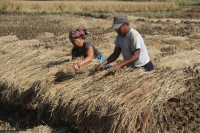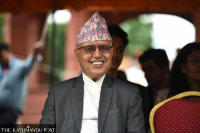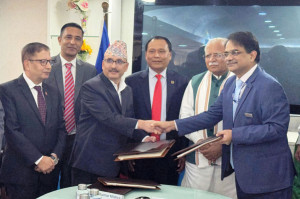Money
Nepal’s largest hybrid wind-solar power system comes online
Nepal’s largest wind-solar hybrid power system came online on Tuesday in Hariharpurgadi village of Sindhuli district. The construction of the hybrid power system was financed by a project supported by the Asian Development Bank (ADB), a Manila-based multilateral lending institution.
Nepal’s largest wind-solar hybrid power system came online on Tuesday in Hariharpurgadi village of Sindhuli district. The construction of the hybrid power system was financed by a project supported by the Asian Development Bank (ADB), a Manila-based multilateral lending institution.
The system is powered by 20-kilowatt wind turbines complemented by 15-kilowatt solar photovoltaic panels.
It produces 110 units of energy per day, which exceeds the village’s daily electricity demand of 87 kWh. The system is currently catering to 83 rural households.
“Access to clean, reliable and affordable energy will help the village to connect to the world through Internet and mobile phones, and will create opportunities to boost local income,” said Mukhtor Khamudkhanov, ADB’s country director for Nepal. “The electricity from the mini-grid will also open the door for commercial activities in the village and help small businesses get off the ground.”
The wind-solar hybrid system was installed under ADB’s South Asia Sub-regional Economic Cooperation Power System Expansion Project.
The project, with a total cost of $16.2 million, was also partly financed by the government of Nepal, the Scaling up Of Renewable Energy Program under the Climate Investment Fund, and the local community.
The installation and operation of the hybrid system, which was implemented by the Alternative Energy Promotion Centre (AEPC), is an attempt to scale up decentralised off-grid approaches to raise rural Nepal’s access to electricity.
Six years ago, the government, with support from the ADB, had launched its first mini grid wind-solar system in Dhaubadi in western Nepal.
“The success of Dhaubadi and Hariharpurgadi projects has demonstrated that clean energy is indeed a viable option to provide reliable energy access to rural Nepal through wind-solar hybrid systems,” said AEPC Executive Director Ram Prasad Dhital.
“Implementation of innovative renewable energy solutions will help the country to achieve the [United Nations-led] Sustainable Development Goals,” said Prakash Mathema, secretary of the Ministry of Population and Environment.




 18.12°C Kathmandu
18.12°C Kathmandu














